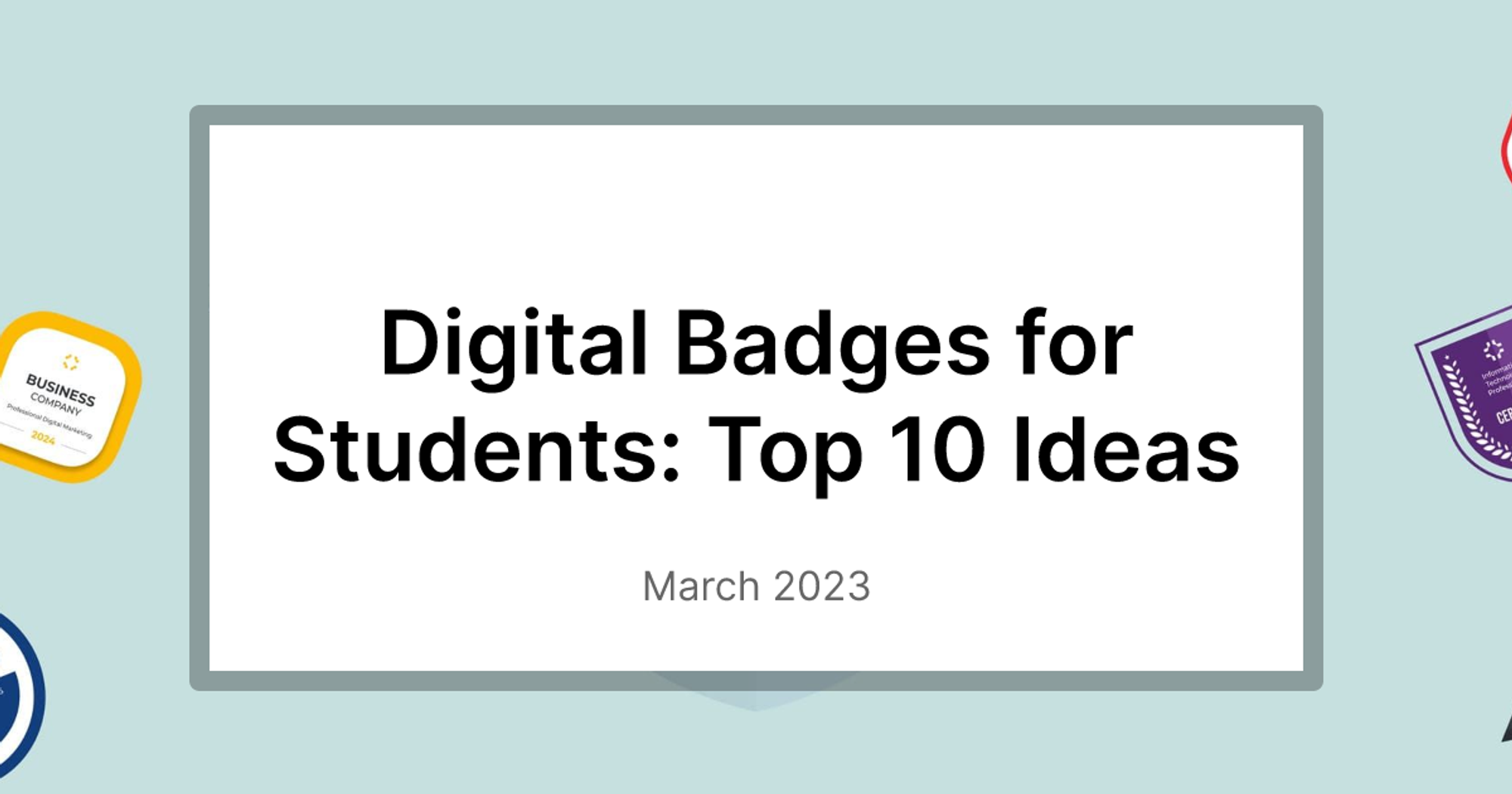Introduction

Open Badges are digital credentials that recognize learning and achievements across various domains and contexts. They are portable, verifiable, and shareable badges that can be displayed on websites, social media platforms, resumes, or portfolios. Open Badges have been around since 2011, when Mozilla launched the first version of the standard and the Backpack platform. Since then, Open Badges have evolved and improved through several versions and standards, with the latest one being Open Badges 3.0.
Open Badges 3.0 is the most advanced and innovative version of the Open Badges standard to date. It aligns with the Verifiable Credentials data model, a W3C specification that enables the creation and verification of digital credentials across different systems and platforms. It also supports blockchain technology, which enhances the security, transparency, and immutability of Open Badges. Moreover, it improves the verification and portability of Open Badges, making them more accessible and user-friendly.
In this blog post, we will explore what’s new in Open Badges 3.0 and how it compares with the previous versions and standards. We will also discuss the features and benefits of Open Badges 3.0 for learners, educators, and employers, and provide some examples and use cases of how Open Badges 3.0 can be used in different scenarios. By the end of this post, you will have a better understanding of Open Badges 3.0 standard.
Open Badges 3.0
Open Badges 3.0 is the latest version of the Open Badges standard, which was released in November 2022 by IMS Global Learning Consortium, a non-profit organization that develops and maintains interoperability standards for education and learning technology. Open Badges 3.0 is based on the Verifiable Credentials data model, a W3C specification that defines a common format for expressing and exchanging digital credentials across different systems and platforms.
Verifiable Credentials

The Verifiable Credentials data model enables the creation of verifiable presentations, which are collections of verifiable credentials that can be presented to a verifier to prove one’s identity, qualifications, or achievements. A verifiable presentation can include one or more verifiable credentials, which are statements that are cryptographically signed by an issuer and contain information about the issuer, the recipient, and the credential itself.
Open Badges 3.0 adopts the Verifiable Credentials data model and extends it with additional properties and features specific to Open Badges. For example, Open Badges 3.0 introduces the concept of badge objects, which are verifiable credentials that represent an achievement or a skill. A badge object can include information such as the name, description, image, criteria, and alignment of the badge, as well as the evidence and expiration date of the achievement or skill.
What is Decentralized Identity (DID)?

Decentralized Identity (DID) is a concept and a model for identity management that gives individuals control over their own identity-related data. Unlike traditional identity systems that rely on centralized authorities or intermediaries to issue, verify, and store identifiers and credentials, DID allows individuals to create, manage, and use their own identifiers and credentials without depending on any third party.
DID is based on open standards and uses decentralized identifiers (DIDs) and verifiable credentials as the main components. DIDs are globally unique identifiers that are stored on the blockchain, which enables the verification of the identity and credentials of people, organizations, and things. Verifiable credentials are statements that are cryptographically signed by an issuer and contain information about the issuer, the recipient, and the credential itself.
DID enables a new model of decentralized digital identity that is often referred to as self-sovereign identity or decentralized identity. DID helps individuals to interact transparently and securely in an identity trust fabric, where they can prove their identity, qualifications, or achievements to anyone they choose.
Open Badges 3.0 Features & Benefits
Open Badges 3.0 supports blockchain technology, which is a distributed ledger system that records and verifies transactions without the need for a central authority or intermediary. Blockchain technology enhances the security, transparency, and immutability of Open Badges, as it prevents tampering, duplication, or loss of badge data. Moreover, blockchain technology enables the creation of decentralized identifiers (DIDs), which are unique and persistent identifiers that can be used to identify and authenticate issuers, recipients, and verifiers of Open Badges.
Some of the main features and benefits of Open Badges 3.0 are:
- Improved verification: Open Badges 3.0 makes it easier and faster to verify the authenticity and validity of badges, as it uses cryptographic signatures and blockchain technology to ensure that badges are issued by legitimate issuers and have not been modified or revoked. Verifiers can also use DIDs to verify the identity and authority of issuers and recipients of badges.
- Enhanced portability: Open Badges 3.0 makes it more convenient and flexible to store and share badges across different platforms and devices, as it uses a common format and standard that is compatible with various systems and applications. Recipients can also use DIDs to control their own badge data and choose how and where to display their badges.
- Increased user experience: Open Badges 3.0 makes it more engaging and rewarding to earn and issue badges, as it allows for more customization and personalization of badges. Issuers can create badges that reflect their brand identity and values, while recipients can create verifiable presentations that showcase their achievements and skills in different contexts and purposes.
These are some of the features and benefits of Open Badges 3.0 that make it a powerful and innovative tool for digital credentialing in the 21st century.
Issues with Open Badges 2.0
Open Badges 2.0 introduced some improvements and features over Open Badges 1.0, such as extensions, endorsements, revocation lists, and JSON-LD data model. However, Open Badges 2.0 also had some issues and limitations that made way for Open Badges 3.0.
One of the main issues with Open Badges 2.0 was the use of email as the identifier for recipients of badges. This meant that recipients had to use the same email address for all their badges, and if they changed their email address, they could lose access to their badges or face verification problems. Moreover, email identifiers raised some privacy and security concerns, as recipients had to share their personal information with issuers and verifiers of badges.
Another issue with Open Badges 2.0 was the lack of support for blockchain technology, which is a distributed ledger system that records and verifies transactions without the need for a central authority or intermediary. Blockchain technology offers many benefits for digital credentialing, such as enhanced security, transparency, and immutability of badge data. However, Open Badges 2.0 did not support blockchain technology, and therefore could not leverage its potential for creating and verifying badges.
These are some of the issues with Open Badges 2.0 that led to the development of Open Badges 3.0, which addresses these issues and offers more features and benefits for digital credentialing. For example, Open Badges 3.0 supports decentralized identifiers (DIDs), which are unique and persistent identifiers that can be used to identify and authenticate issuers, recipients, and verifiers of badges. DIDs solve the problems of email identifiers, as they allow recipients to control their own badge data and choose how and where to display their badges. Moreover, Open Badges 3.0 supports blockchain technology, which enhances the security, transparency, and immutability of badges, as it prevents tampering, duplication, or loss of badge data.
Open Badges 3.0 vs Previous Versions
One of the main questions that you might have about Open Badges 3.0 is how it differs from the previous versions and standards of Open Badges. To answer this question, we have prepared a comparison table that summarizes the main features and characteristics of Open Badges 3.0, 2.0 and 1.0. This table will help you understand the evolution and improvement of Open Badges over time, and the advantages and disadvantages of each version and standard. You can also use this table as a reference guide to decide which version or standard of Open Badges is best suited for your needs and goals. Here is the comparison table:
Feature | Open Badges 3.0 | Open Badges 2.0 | Open Badges 1.0 |
Data model | Verifiable Credentials | JSON-LD | JSON |
Image | Optional | Required | Required |
Blockchain | Supported | Not supported | Not supported |
Decentralized identifiers (DIDs) | Supported | Not supported | Not supported |
Verifiable presentations | Supported | Not supported | Not supported |
Badge objects | Supported | Supported | Supported |
Extensions | Supported | Supported | Not supported |
Endorsements | Supported | Supported | Not supported |
Revocation lists | Supported | Supported | Not supported |
Current State of Open Badges 3.0
Open Badges 3.0 was released as a Candidate Final Public Specification Version 3.0 on November 10, 2022, after a period of public review and feedback from the 1EdTech membership and the wider Open Badges community.
The final spec sheet of Open Badges 3.0 is available on the IMS Global website, along with the implementation guide, certification guide, errata, and issue tracker. The final spec sheet defines the properties and procedures for creating, issuing, verifying, and displaying Open Badges 3.0, which are based on the Verifiable Credentials data model, a W3C specification that enables the creation and verification of digital credentials across different systems and platforms.
The development of Open Badges 3.0 is not over yet, as there are still some aspects that need to be refined and improved. For example, there are some open issues and questions regarding the use of blockchain technology, decentralized identifiers (DIDs), verifiable presentations, and badge objects in Open Badges 3.0 . Moreover, there are some challenges and opportunities for implementing and adopting Open Badges 3.0 in different contexts and scenarios, such as education, employment, lifelong learning, and social recognition.

One of the platforms that is planning to support Open Badges 3.0 is Certopus, a digital credentialing platform that allows users to create, issue, and verify badges using blockchain technology. Certopus is currently compatible with Open Badges 2.0, but it aims to upgrade to Open Badges 3.0 as soon as possible to offer its users the benefits and features of the latest version of the standard.
Frequently Asked Questions ( FAQ )
What is Open Badges 3.0 and how does it work?
Open Badges 3.0 is the latest version of the Open Badges standard, which is a way of creating, issuing, verifying, and displaying digital credentials that recognize learning and achievements across various domains and contexts. Open Badges 3.0 works by using the Verifiable Credentials data model, a W3C specification that defines a common format for expressing and exchanging digital credentials across different systems and platforms. Open Badges 3.0 also supports blockchain technology, which enhances the security, transparency, and immutability of badge data.
What are the benefits of Open Badges 3.0 for learners, educators, and employers?
Some of the benefits of Open Badges 3.0 for learners, educators, and employers are:
- For learners: Open Badges 3.0 can help learners showcase their achievements and skills in a verifiable and portable way. They can also use their badges to demonstrate their learning progress, gain recognition, access opportunities, and build their personal brand.
- For educators: Open Badges 3.0 can help educators design and deliver engaging and personalized learning experiences. They can also use their badges to recognize and motivate learners, provide feedback and guidance, assess learning outcomes, and align learning with standards and competencies.
- For employers: Open Badges 3.0 can help employers identify and celebrate talent and growth. They can also use their badges to attract and retain talent, validate skills and qualifications, provide incentives and rewards, and foster a culture of learning and development.
What are the differences between digital certificates and digital badges?
Open Badges and digital badges are both online representations of skills and achievements, but Open Badges are a specific type of digital badges that follow a standard for creating, issuing, verifying, and displaying badges across different systems and platforms
Need more information?
Book a demo to learn more about Certopus for your business use-case, or if you have any questions, please contact us. We would be delighted to assist you. Finally, if you're on social media, follow us to remain informed about our latest developments and to learn more about digital credentials like digital certificates, digital badges and micro-credentials.
Recommended Articles:
_(1)_(1)_(1).jpg?table=block&id=bb52c6e6-6cda-4b3f-b0ac-34e118ac8424&cache=v2)


